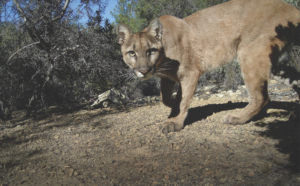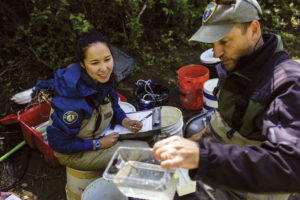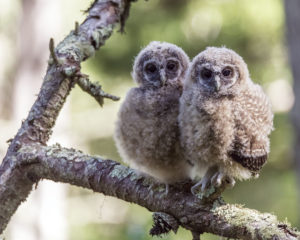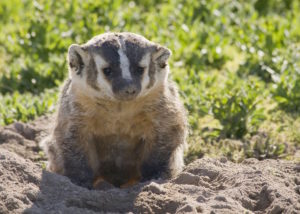“You know it is very, very unlikely we will actually see a badger, right?” National Park Service wildlife ecologist William Merkle says, trying to manage my expectations as we hike through Roy’s Redwood Preserve in San Geronimo Valley in early spring. With Lisa Michl from Marin County Parks and Open Space District, we are headed to inspect the site where a motion-activated camera has recently documented a badger, its black-and-white triangular head making an instantaneous appearance in one frame among literally thousands of pictures of grass waving in the breeze. My own image of a badger has a lot to do with the gentlemanly host of the underground in Kenneth Grahame’s classic children’s novel The Wind in the Willows. “Badgers have become mythical to us,” Merkle notes, “because we hardly ever see them.” I persist in hearing the friendly banter of Badger, Rat, and Mole, even as I reflect that Taxidea taxus would in reality not give Rat and Mole a tour of his domain but instead consume them in one or two bites.
Remember, they are an exotic species in the Western United States, and are rapidly increasing their geographic range and range of habitats. Are they outcompeting or excluding native species in the process? How would we know? We have done almost nothing to monitor changes in the assemblage of mushroom species in areas before and and after the incursion of death caps.
Further Reading
Pringle et al, “The ectomycorrhizal fungus Amanita phalloides was introduced and is expanding its range on the west coast of North America,” Molecular Biology 2009
Lockhart et al, “Simultaneous emergence of multidrug-resistant Candida auris on 3 continents confirmed by whole-genome sequencing and epidemiological analyses,” Clinical Infectious Diseases 2017
Battalani et al, “Aflatoxin B1 contamination in maize in Europe increases due to climate change,” Scientific Reports 2016
Mount Tamalpais: A Mountain of Stories

A Mountain of Stories was produced by Bay Nature magazine with the generous support of the Tamalpais Lands Collaborative for publication in the October-December 2017 issue of the magazine. Read more stories from the mountain:
- Meet Mount Tamalpais, by John Hart
- Nature and Culture Mix in a Theatre Among the Oaks, by Claire Peaslee
- The Nature of the Dipsea Race, by Alisa Opar
- Alice Eastwood and the Plants of Tamalpais, by John Hart
- On the Hunt for Mount Tam’s Two Known Badgers, by Mary Ellen Hannibal
- Snorkel Surveys Reveal the World of Mount Tam’s Creeks, by Ariel Rubissow Okamoto
Badgers are of special interest in the One Tam area, partly because of their scarcity and partly because they play an important role in the grassland ecosystem that is their preferred habitat. Today, native grasslands are among the top ten most endangered ecosystems in the United States, according to the nonprofit Defenders of Wildlife, and in the top five in California. “We have less than one percent of our native grasslands,” says Andrea Williams, a Marin Municipal Water District botanist. Calling them “the old growth at your feet,” she explains that native grasslands are an ancient ecosystem tying us to a past California landscape that endures in remnants today. We have about 50 native grasses in the One Tam area, but what we call grasslands is also home to rich centers of diversity, including meadowfoam, clover, baby stars, and lupine—endemic wildflowers that in turn host endemic butterflies. “They provide forage and nesting areas for hundreds of species of native bees,” Williams says. “Birds like horned larks, western meadowlarks, and grasshopper sparrows also prefer areas of bare ground among grass clumps, which animals like badgers and other fossorial mammals create.”
Fossorial means underground, and the fact that this is where badgers dwell is one reason we don’t know that much about them. They have also been hunted and persecuted for so long we don’t have a good picture of their history. Around Mount Tamalpais, there’s been no effort to understand their population until recently. As far back as 1937, famed zoologist Joseph Grinnell and his colleagues wrote that the California badger was threatened with complete elimination by an “overzealous campaign to remove all the native animals from the range because they might prove unfriendly to some phase of agriculture.” They cautioned that badgers act “as a check upon rodent irruptions” and ought not to be treated as “vermin.” Today, though the rarity of badgers gets the designation “species of special concern” in California, there is no limit on hunting them for more than a quarter of the year in the state.
The challenges of puzzling out the badgers, their history in the landscape and their continuing impacts here, are increasingly coming into focus thanks to an innovative monitoring platform called the Wildlife Picture Index (WPI). One Tam’s WPI project includes a grid of 128 cameras arrayed throughout the Lagunitas Creek corridor. Since September 2014, these cameras have borne witness to the wildlife doings in their purviews. They’ve documented a wide variety of mammal activity, revealing skunks, foxes, coyotes, bobcats, and deer, among others. Volunteers help maintain the cameras and identify the wildlife caught on camera. In 2016, volunteers catalogued more than 800,000 images from One Tam’s WPI project. My 16-year-old son and I occasionally assist in this gigantic task. One memorable afternoon we sat in the Sky Oaks Ranger Station looking at photo after photo on computers. The photo memory card assigned to my son that day revealed a veritable bestiary of species, while on mine I watched what appeared to be a single woodrat run around a tree trunk twice a day. I actually felt pretty fond of the critter by the time I was through.
The Wildlife Picture Index sounds like a simple tool: put a bunch of cameras in a landscape and see what images they capture. “One thing we’re learning is that the medium-size carnivores are pretty much everywhere,” Rosa Schneider told me. Schneider is Community Science Program Manager for One Tam, and Schneider’s are the eyes that first saw the badger caught on film at Roy’s Redwoods. Cameras can get triggered as a hiker walks by; one frame might show a backpack or a leg going forward, the next might then reveal a bobcat, a fox, or a coyote trotting past unbeknownst to the human who came before. The ubiquity of the carnivores signals a healthy landscape. On the one hand, it means there is plenty of prey for these animals. On the other, it means we have sufficient predators to keep those prey populations in balance. The presence of these midsize carnivores is a heartening find that tells us the One Tam area is ecologically pretty healthy.
This secret life of One Tam’s fauna is beguiling enough, but the WPI reveals much more. The platform is organized according to strict protocols so the data it collects can be used in sophisticated statistical analysis. For example, it can help pinpoint trends in biodiversity—is it increasing, decreasing, or stable?—and whether large tracts of landscape are well-connected with each other or not. WPI data can be sorted to measure the abundance of an individual species, like the badger, but can also reveal relationships among what biologists call “trophic” levels in the ecosystem. Trophic basically means food—who eats what, in what amounts, at what time of year—and is a fundamental way to assess landscape health. Among many other things (they are omnivorous), badgers eat rodents, and in doing so they help modulate rodent populations. Healthy rodent populations in turn help support other species. The badger and the spotted owl (for example), though they occupy different habitat types and don’t so much as say boo to each other, are thus intimately connected: This trophic relationship ties the health of the grasslands where the badger lives to the health of the forest where the owl lives.
Merkle and I stop on a hillside and look at a camera aimed unobtrusively ahead. He points out a mound of unearthed soil, musing it could possibly be the work of a badger. Belonging to a mammal family called mustelids that includes the wolverine and the mink, badgers are considered ecosystem engineers because their digging aerates the soil, churns up the seed bank, and facilitates water flow. Their dens also provide shelter for other species, including burrowing owls, lizards, insects, and amphibians. In short, they help maintain healthy grasslands—an important part of a diverse habitat mosaic. Yet “we have relatively few acres of grassland, relative to forest and chaparral,” Merkle says.
The grasslands we do still have here face myriad threats. Historically, native Californians controlled the vegetative and faunal succession unfolding on the landscape by periodically burning it. Today we don’t let a single spark fly if we can help it, but that means our grasslands are vulnerable to being taken over by chaparral, Douglas-fir, and invasive nonnative species like French broom. “We have to maintain our grasslands by physically removing encroaching species,” Merkle points out. A healthy population of badgers won’t solve all the grassland problems here, but it will provide another layer of ecosystem resilience to help the land stay healthy and functioning.
WPI project not only helps assess where badgers are today but also makes it possible to set a quantitative goal for their future existence here. Currently, we know there are at least two badgers in the One Tam area, but scientists suspect there are more they haven’t yet confirmed. One Tam would like to maintain at least six suitable habitat patches of greater than 1,000 acres in its area of focus and would like to “detect badgers at all camera locations in grassland or coastal scrub greater than 1,000 acres,” the Peak Health report reads. As Merkle and I look around at the grass and the redwoods beyond, I wonder who, exactly, might be watching us from where.





